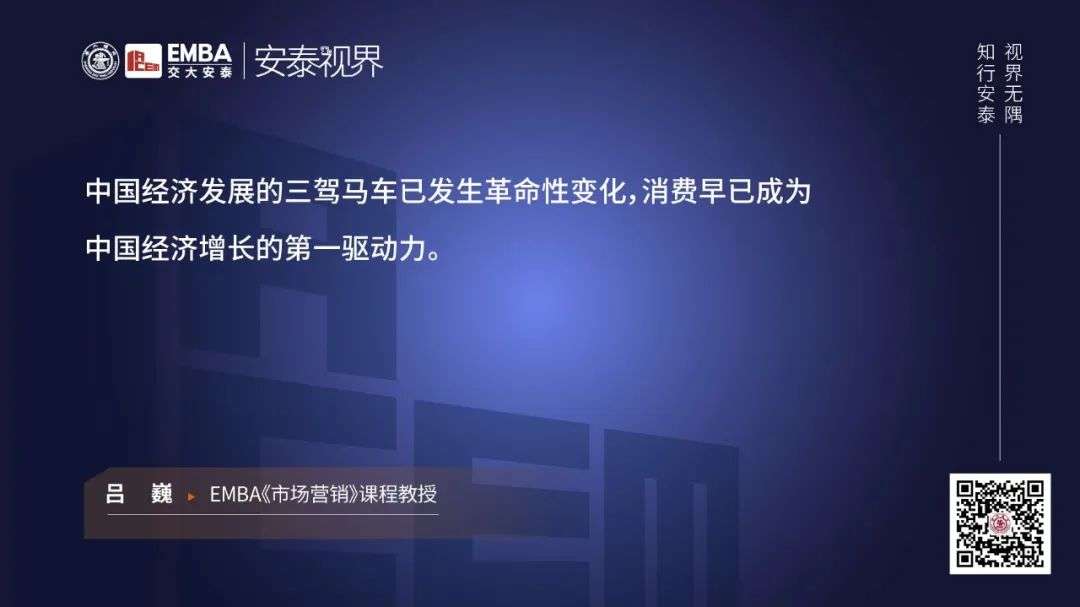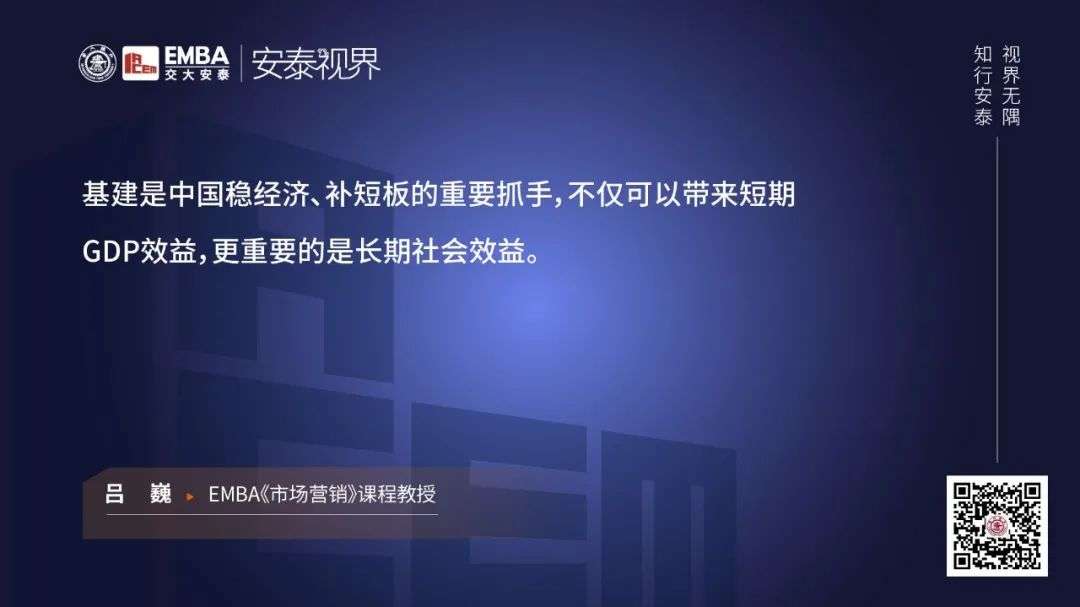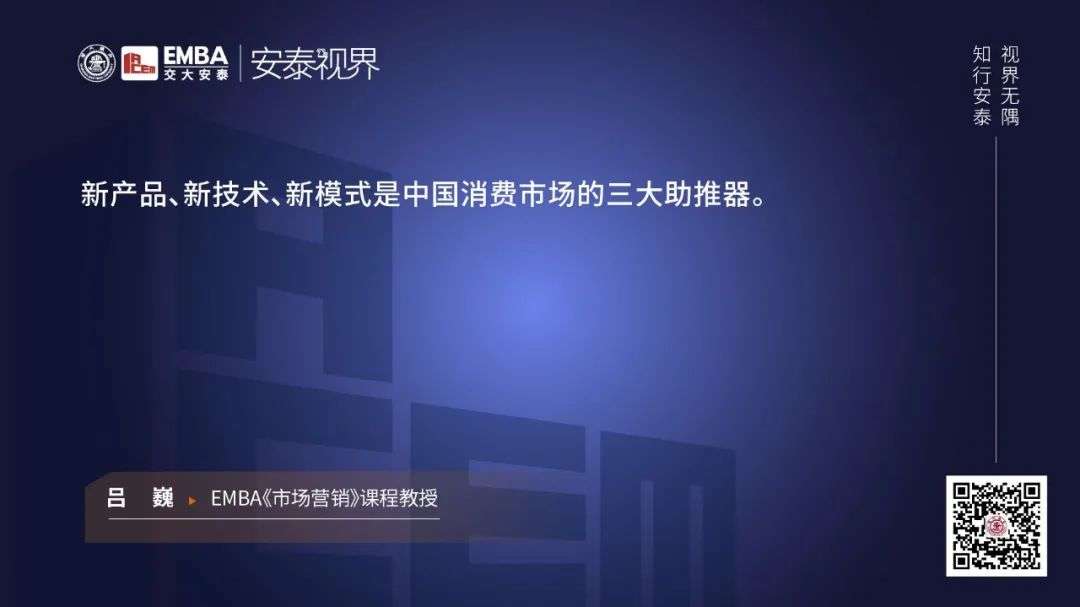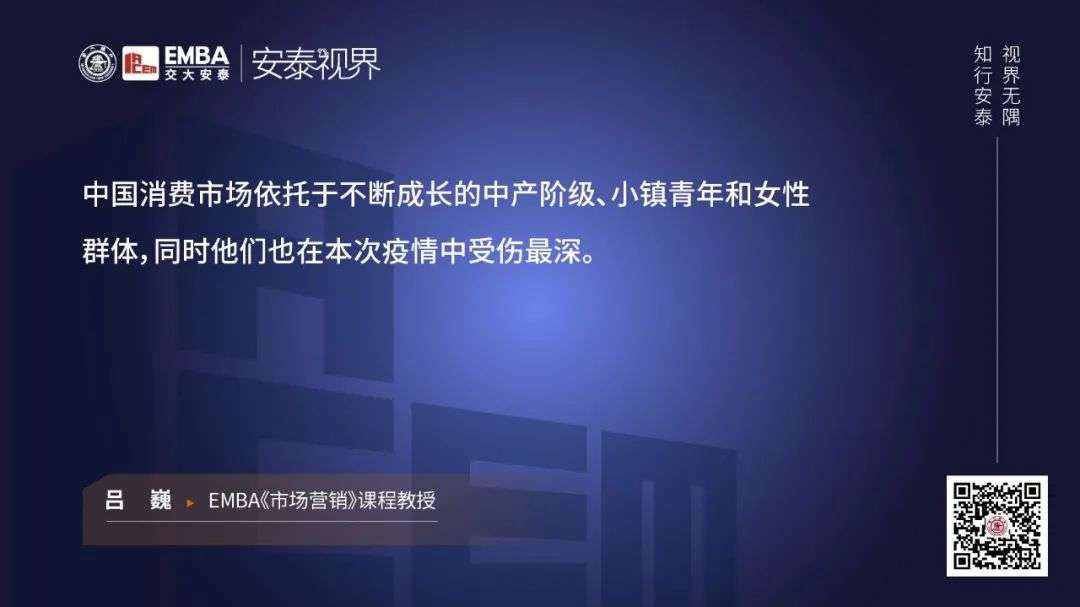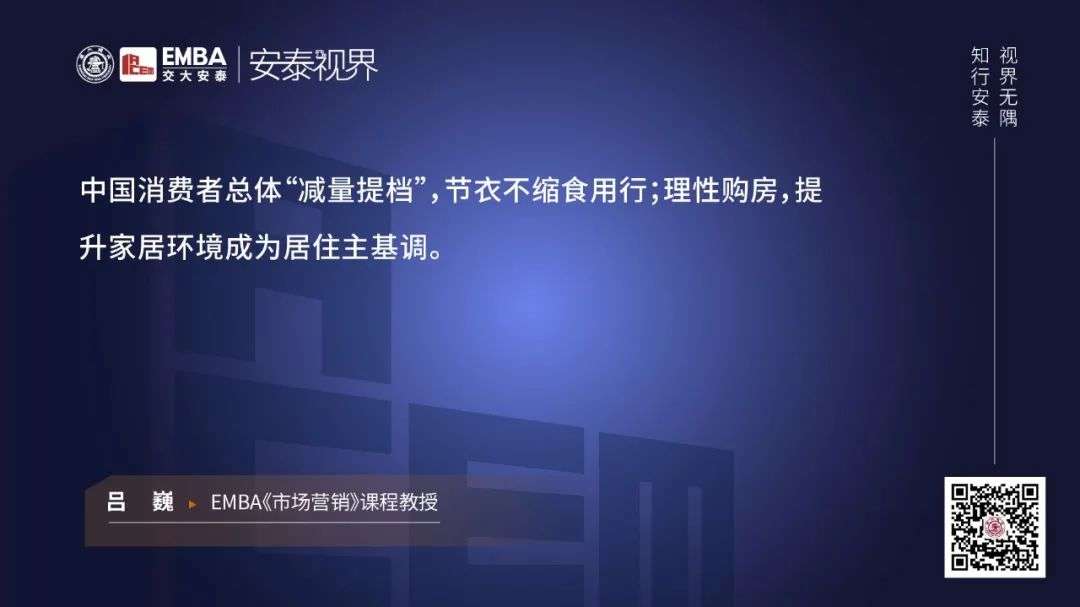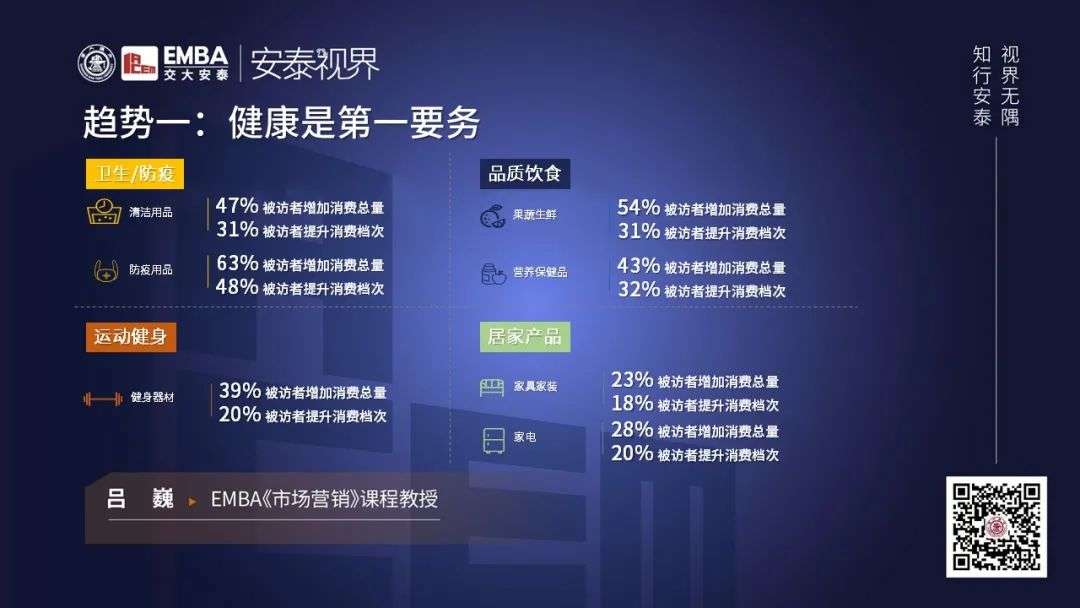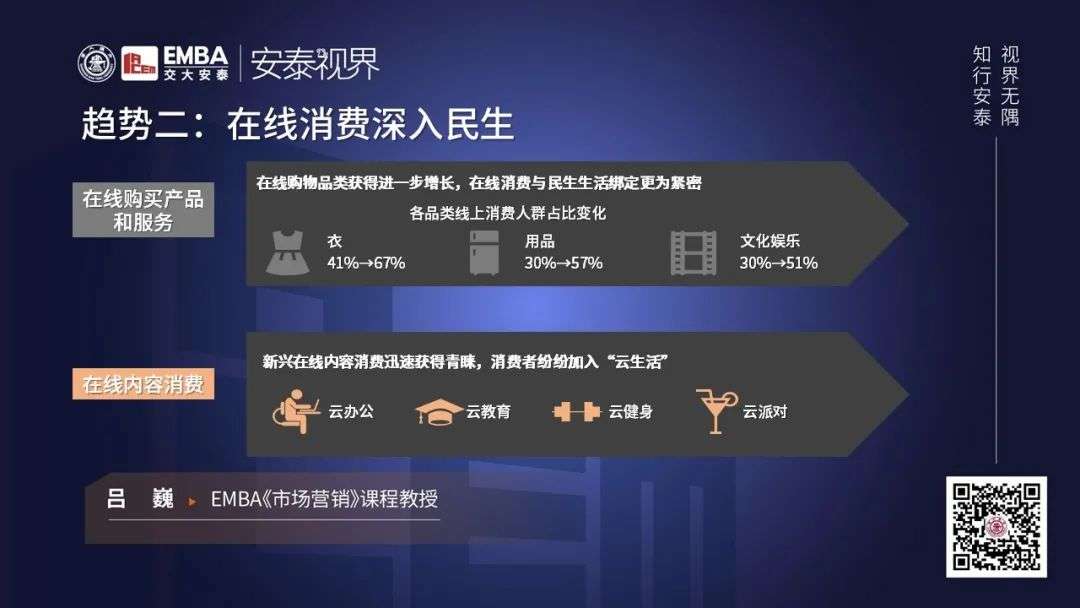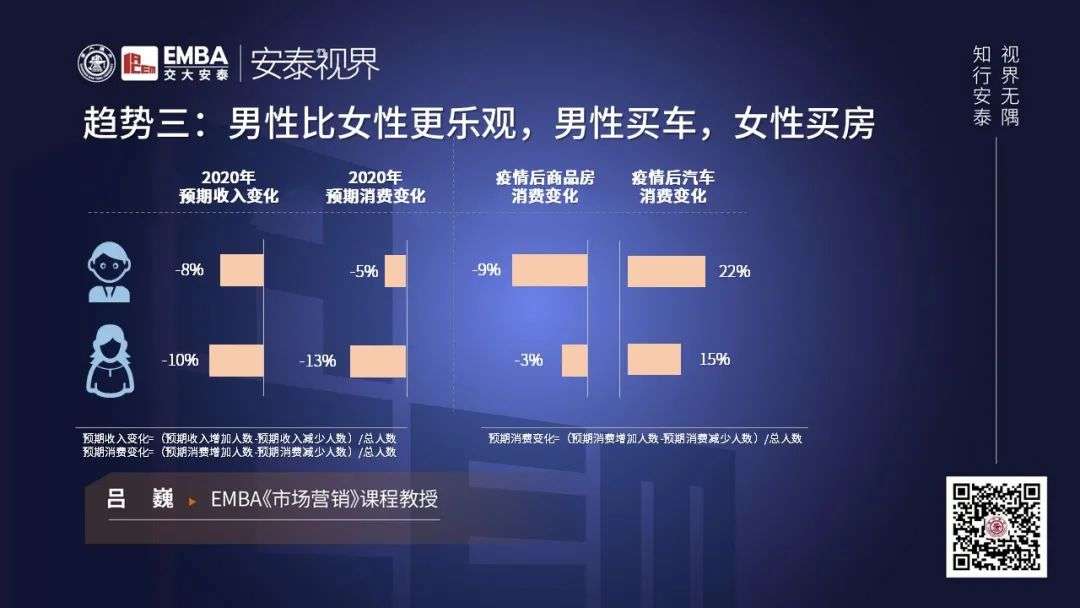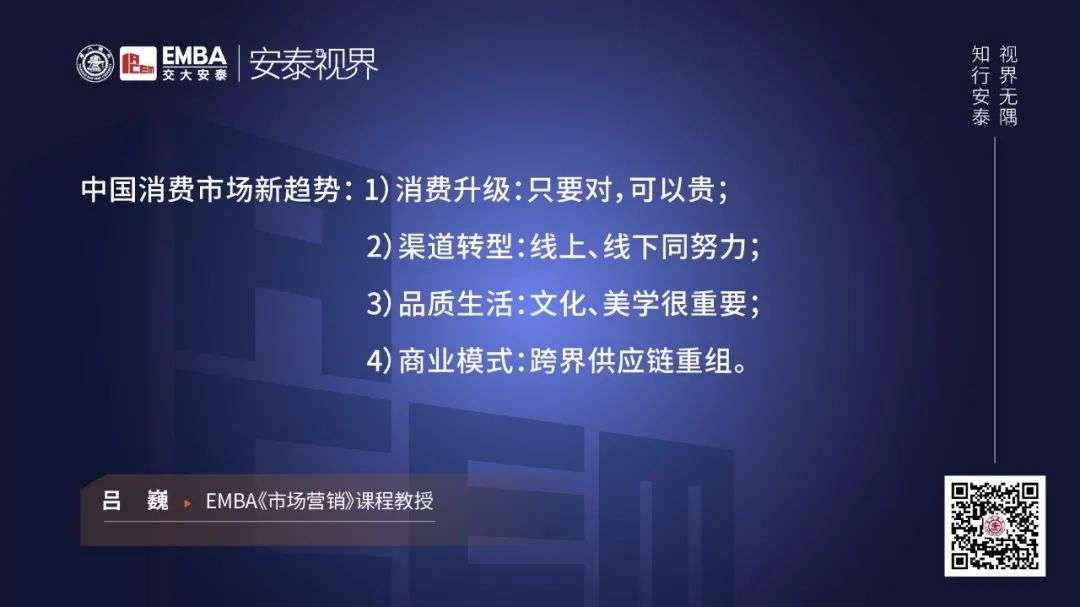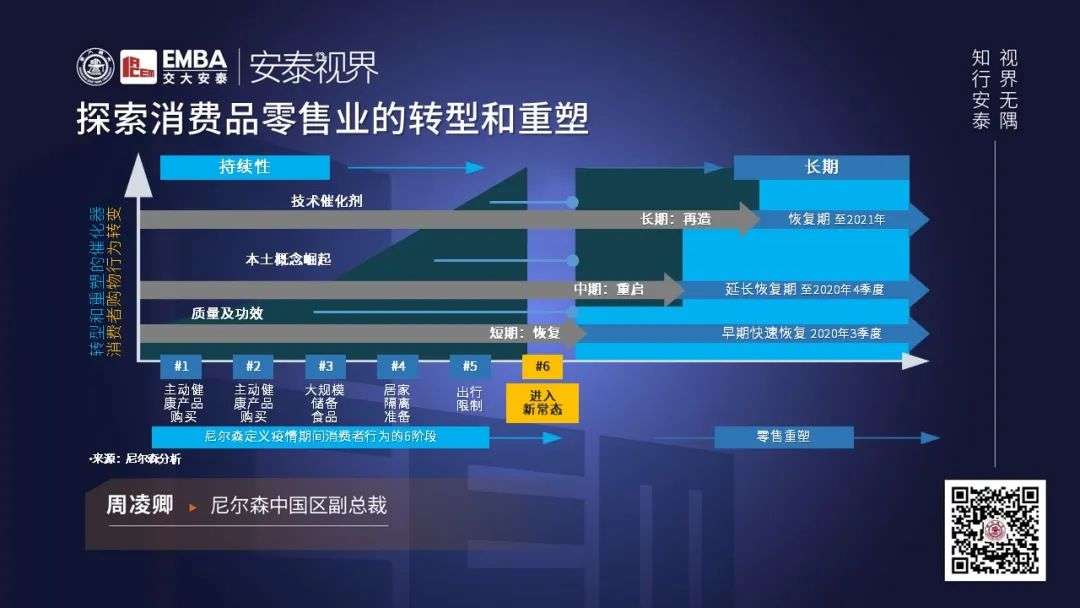As the basis of people’s livelihood, how can consumption play a fundamental role in stabilizing the economy?
Editor’s note: This article comes from the WeChat public account “Shanghai Jiaotong University Antai EMBA” (ID:antaiemba), author : ANTAI EMBA. Original title “Symphony of the Two Congresses, Talking about the Power of Consumption Source and the New Normal | Antai Vision”
May 29th, focusing on the consumption source power after resumption of work, Lu Wei, professor of Antai EMBA “Marketing” course at Shanghai Jiaotong University, and Zhou Lingqing, vice president of Nielsen China After the epidemic, consumers’ mentality changes, consumption source power and the new normal of the consumer market were shared.
The just-closed NPC and CPPCC plans to stabilize China’s economic fundamentals and highlight the “six guarantees and six stability”. So, what is the source of the “six guarantees and six stability”? As the basis of people’s livelihood, how can consumption play a fundamental role in stabilizing the economy? Lu Wei believes that initiating consumption is still the fundamental way to stabilize the economy. In the later stage of the epidemic, Chinese consumers’ mentality will show seven trends: health pursuit and online consumption. Consumption concept. Regarding the transformation of the consumer retail industry after the epidemic, Zhou Lingqing believes that the new lifestyle under the epidemic is defining new needs. There are differences in the source and power of the transformation and remodeling of the consumer retail industry after the epidemic. Accelerated technological changes will further strengthen consumer remodeling and upgrading. Companies need to identify emerging consumer groups.
Lu Wei: Stimulate the source of consumption
1 Starting consumption is still the fundamental way to stabilize the economy
The global economic recession has been finalized, and the economic recovery has been hindered and long. In response to the economic downside risks caused by the epidemic, countries have successively launched economic assistance policies, which are mainly reflected in three aspects: first, the implementation of bottomless quantitative easing and increased liquidity; second, the provision of economic assistance to individuals or families; and third, special projects for enterprises Capital injection support. From the epidemic prevention war to the resumption of war to the defense war, China’s keywords are changing. In 2020, the two sessions will not set specific targets for economic growth and macro leverage indicators. The top priority is to protect people’s livelihood and employment. So, how can the economy be maintained? How can we keep it?
Lv Wei believes that the troika of China’s economic development has undergone revolutionary changes: infrastructure can create economic benefits in the short term, but it will mainly bring social benefits in the long run; affected by the epidemic and the international environment, exports have been seriously frustrated; therefore, consumption It has long been the first driving force for China’s economic growth, and inspiring consumption is in line with the national strategic goal of achieving poverty alleviation and well-off society, as well as the people’s longing for a better life.
2 Analysis of the mentality of Chinese consumers in the later stage of the epidemic
Before the outbreak, due to the overall stability of the Chinese economy, the consumption trend index continued to maintain a high level of operation, of which employment is expected to contribute the most to the Chinese consumption index. In recent years, the strength of China’s consumption has mainly relied on the rise of the middle class, lower-tier cities and women’s consumption. The continuous emergence of new technologies (online channels, etc.), new products (consumer credit services, etc.) and new business models (new retail, sharing economy) have further stimulated the growth of China’s consumer market.
In order to understand the trend of China’s consumption after the epidemic, Jiaotong University, Antai, together with EMBA and MBA outstanding student enterprise Kurun Data, and Xeduo Consulting cooperated and released the “Consumer Insight Study in the Later Period of the Epidemic”. In terms of spending power, 34% of respondents expect revenue to decline this year, and 63% of respondents expect revenue to rise next year. In 2020, China’s four major consumer forces (females, post-80s, middle-class, and township youths) will be severely damaged. Among them, women, post-80s/90s, and township youths are more pessimistic about their income recovery next year.
In terms of willingness to consume, 36% of the respondents expect that consumer spending will decline this year, and 42% of the respondents expect consumer spending to rise next year. In 2020, the expected consumption expenditures and consumption recovery ability of women and young people in towns have been severely frustrated. From the perspective of categories, consumers will “save clothing”, but not “food, use, and travel”.
Lv Wei believes that after the epidemic, consumption shows seven trends: first, health is the first priority; second, online consumption is deeply rooted in people’s livelihood; third, men are more optimistic than women, men buy cars and women buy houses; Fourth, youth consumption is the most frustrated, middle-aged to protect the body, happy old age; Fifth, first-tier cities look at the future, second-tier cities re-live life, and lower-tier cities seek development; sixth, the consumption concept of different gender, age, and class groups after the outbreak Both will be more rational and conservative; seventh, “rate cuts”, “subsidies” and “increased employment opportunities” will enhance consumer confidence.
3 How to stimulate the source of consumption?
First of all, it is the government side, and “security” is still the current keynote. On the one hand, the new coronavirus may exist for a long time, and the government needs to formulate management methods for normalization of the epidemic situation, strictly guard against death, and implement precise policies to defend the fruits of victory in epidemic prevention and control. On the other hand, small and medium-sized enterprises are affected by the epidemic, and their survival is difficult and the rate of failure is high. The low-income people, migrant workers and the middle-income class are the hardest hit by the epidemic. At the same time, by issuing economic subsidies or consumption vouchers to low-income families and unemployed people, lowering interest rates on middle-income housing loans and appropriately lowering individual taxes, etc., release consumer demand and stimulate consumption vitality.
Secondly, the enterprise side needs to be keenly aware of consumption trends. First, consumption upgrade is an opportunity, the focus is not simply selling expensive products, but to provide consumers with good competitive products in line with the trend; second, channel transformation is inevitable, more interest circles emerge in online cities, and short videos become rookies, Opening up online and offline is the outlet of marketing channels; third, quality life is the pursuit, rational consumption fosters higher expectations and values, and products should carry more content than satisfying functions, such as aesthetics, cultural connotation, and good morals Wait: Fourth, the business model needs to be changed. Due to changes in the environment, the entire supply chain is in the stage of restructuring. Enterprises should actively use their own advantages and technological development to restructure the new business model.
Finally, the consumer side, consumers need to establish a healthy consumption concept. First, China’s own market conditions make us confident in China’s economy and consumption; second, consumers are prepared for a long-term anti-epidemic battle and make healthier and more reasonable consumption; third, consumers should focus on strong fitness Body, enrich life and enhance self.
Zhou Lingqing: Changes in the retail of consumer goods after the new coronary pneumonia epidemic
1 Road to the recovery of consumer goods retail under the epidemic
The Nielsen Consumer Survey during the epidemic (February 24-29) showed that 92% of consumers have full confidence in the Chinese epidemic, mainly from the Chinese government’s timely and transparent information disclosure and proper prevention and control measures. . In addition, 72% of consumers believe that the Chinese epidemic will end in the next 1-3 months.
Under the epidemic, online retail maintained the same growth rate in 2019, offline retail began to recover in March, and omni-channel retail in the first quarter of 2020 served as a consumption stabilizer. As of the end of March, 70% of offline retail has not fully recovered, but community-based small supermarkets have benefited from convenience, close-to-life product mix, and rapid development of O2O, which have been stable during the epidemic. Zhou Lingqing believes that 30% of the rural market will become one of the important sources of consumption during and after the epidemic, and it has huge potential for consumption upgrades in personal care products, household products, and main and auxiliary food fields.
The weekly monitoring platform of the omni-channel head retailer showed more keenly that the fast-moving consumer industry gradually recovered at the end of March and April, and Chinese consumption gradually returned to the right track. In the past four months, new lifestyles are defining new needs. For example, cooking at home makes packaged flour, quick-frozen snacks, high-end soy sauce products and other convenient-storage foods sell well, and health management polarizes the purchase of reactive and active health and hygiene products, and leisure enjoyment makes pre-mixed wine, vodka and other categories Sales volume has increased significantly.
2 Source of consumption power: the new normal of the consumer market after recovery
Zhou Lingqing believes that China’s consumer retail market can quickly emerge from the impact of the epidemic, showing a U-shaped or V-shaped rebound. After the pain, it is bound to reflect a strong rebound, which has been verified by the rapid recovery and substantial growth after the 2009 financial crisis.
The transformation of consumer shopping behavior is a catalyst for the transformation and remodeling of consumer goods retail. After the recovery, the new normal of the consumer market is reflected in three aspects: First, during the epidemic, consumers’ living habits have changed, and they are more pursuing open spaces, respecting personal values, virtual superiority to entities, returning to local brands, authenticity and More reliable products, andHealthy eating, routine medical examinations, and insurance purchases. The second is the adjustment of the consumer goods and retail industries, through products, scenarios, pricing, social media and other channels to comprehensively upgrade the brand experience. The third is the rise of new consumption values and consumer groups, which is reflected in the rise of localization and individualized consumption concepts. Young single consumers pay more attention to the realization of self-investment and self-value, and promote the prosperity of the night economy.
In general, there are differences in the driving forces behind the transformation and remodeling of China’s consumer retail industry after the epidemic. Accelerated technological changes and references will further strengthen consumer remodeling and upgrading. Zhou Lingqing said that consumer wallets will be redistributed, consumer product category selection will be rebalanced, consumer product prices will be reassessed, and consumer product brand value will be repositioned to form origin and neighborhood-type shopping preferences. Enterprises need to identify future consumer groups.
Round table conversation
The round-table dialogue was hosted by Liu Jiangxian, an alumnus of AMBA EMBA 2011 Fall Class 1 of SJTU and SMG Rong Media Center. The development of small and medium-sized enterprises is directly related to the effect of consumption on the economy and the recovery of the national economy. Focusing on the favorable policies released by the two associations, SMEs will carry out interactive discussions.
Lv Wei believes that SMEs provide more than 70% of China’s jobs, and the protection of people’s livelihood and employment depends on the performance of SMEs. At present, the situation of SMEs is relatively difficult, which is reflected in two aspects: First, the national status treatment of private enterprises has not been completely determined; Second, SMEs themselves also have weaknesses, such as weak financial strength, technical strength, and management strength. Strong winds and waves. The government needs to identify which enterprises are facing short-term difficulties due to the epidemic, and then provide financial support to help them adjust and upgrade. We can learn from the foreign SME administration system. In addition to tax cuts, the government can also provide targeted R&D subsidies to SMEs to help them confidently carry out technology transformation.
Zhou Lingqing believes that SMEs need to be more confident. First, as consumption upgrades, consumers’ preferences for domestic products and SMEs are tangible. Second, SMEs’ supply chain and crisis response capabilities are more flexible, and innovation vitality is stronger. . We can learn from foreign experience and help small and medium-sized enterprises grow rapidly through domestic large business incubators.
(This article is based on the live content of Professor Lu Wei and Mr. Zhou Lingqing)

